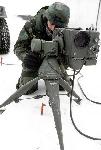



Lasers produce beams of light that can be controlled and focused to a width of only a meter across at tactical ranges (2-3 km). These beams can be made to switch on and off in a few billionths of a second. This allows the beams to be coded. The small size and the coded identification of the light spot makes lasers useful as a target marker or designator. Homing missiles or shells and close air support aircraft can be guided by these lasers to engage a target at long ranges. The fast switching action also allows the use of the laser light to measure distances in land surveying equipment and rangefinders. Lasers make superb range finders. The laser beam is switched on and off in a few billionths of a second producing a very short pulse. The pulse travels to the target, where some light is reflected back. A timer inside the rangefinder measures how long the pulse took for the round trip. Time is then converted into a distance to the target. The fast switching of the beam on and off allows the pulses to be timed. Timing can be used to code the laser beam so that a sensing device will only detect the spot from that beam. The precise beam allows a very small light spot to be formed on a distant target. A small detector can be built into an artillery shell, guided missile or bomb that will lock on a single coded light spot and ignore all others. This allows aircraft or artillery systems to be guided to a direct hit on a point target.Fielded US portable laser rangefinders and rangefinder/designators include:
- AN/GVS-5. This is a handheld near infrared laser rangefinder, with one eye piece and weighs 5 lbs.
- AN/PAQ-1 Laser Target Designator (LTD). This is a near infrared laser rangefinder/designator used to obtain target range. It is also used with homing weapons such as the Copperhead 155 mm, HELLFIRE and Maverick missiles and guided bombs. They home in on a laser spot from this shoulder/ tripod-mounted1 16 lb. device.
- AN/TVQ-2 Ground/Vehicular Laser Locator Designator(G/VLLD). This near infrared laser is used in the same way as the (LTD), and is operated on a tripod mount or the Fire Support Team Vehicle. Its greater power and accuracy allow for spotting targets at greater distances. It weighs 52 lbs.
